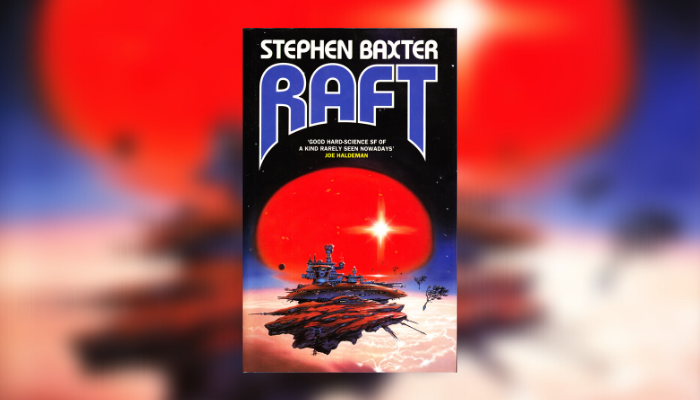|
British writer Stephen Baxter is best known for his sprawling Xeelee Sequence, which he has been working on intermittently throughout his long career. Released in 1991, Raft is the first of his novels and is only tangentially related to his magnum opus. Drawing heavily on Baxter's background in physics and on the hard sci-fi tradition, Raft is based on a simple but thoroughly mind-bending idea: how would humans survive in an environment where the force of gravity was a billion times stronger than in our world? The "raft" of the title is a great disc floating within a mysterious nebula. It is one of the last remnants of a spacecraft built by humans which accidentally passed through "Bolder's Ring" and and crossed from our universe into one with vastly stronger gravity. This event took place 500 years and many generations before the setting of the story, so the surviving humans eking out a living in this incredibly harsh environment know hardly anything of Earth - which to them is little more than a legend.
Baxter's protagonist, Rees, has an even harder life than the residents of the Raft. He is a miner, labouring to extract iron from the kernel of a long-dead star, which the downtrodden miners trade for food and supplies with the Raft. Naturally, this relationship allows Baxter a means to explore the dynamics of class in his story and there is a rich political seam that runs through the novel. That being said, the characters in Raft are fairly thin and the dialogue is not particularly engaging. It's the science that most concerns the author, and his grasp of the principles allows him to depict a world which is both wildly alien and just about believable. Gravity is so strong in the world of the novel that planets as such cannot exist - they would simply implode under the gravitational pull of their own mass. Conversely, humans can live on objects just a matter of yards across, so powerful are gravitational fields. Rees is a classic sci-fi hero in the sense that he is unendingly curious - he has a natural flair for the scientific method even before he receives training from the Raft's caste of experts. His quest for answers leads him to stow away on a flying tree - the main method of travel in the nebula - to escape his home on the Belt. Later, Baxter explores the grisly possibilities of his universe when Rees encounters the "Boneys". These outcasts have a grim lifestyle imposed on them by the fact that corpses cannot reach escape velocity... Raft is very assured for a debut novel and having a fairly modest length, is quite accessible. It may not have the most exciting characters or dialogue, and can be very bleak, but it is packed with intriguing scientific ideas which Baxter threads into an engaging story. If you're in any way interested in the sci-fi of the early '90s or Baxter in particular, it's definitely worth a look.
0 Comments
Your comment will be posted after it is approved.
Leave a Reply. |
About
Exploring classic science fiction, with a focus on the 1950s to the 1990s. Also contributing to Entertainium, where I regularly review new games. Categories
All
|

